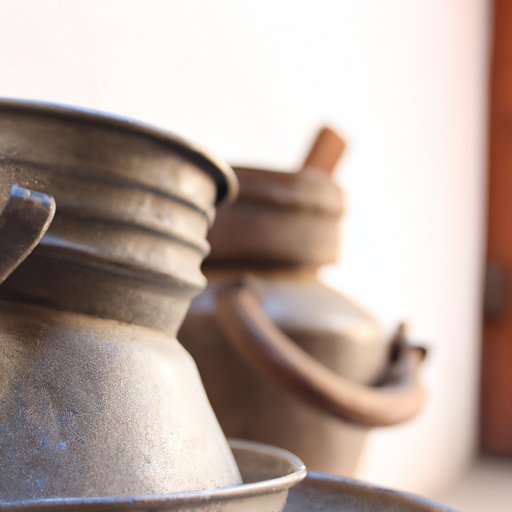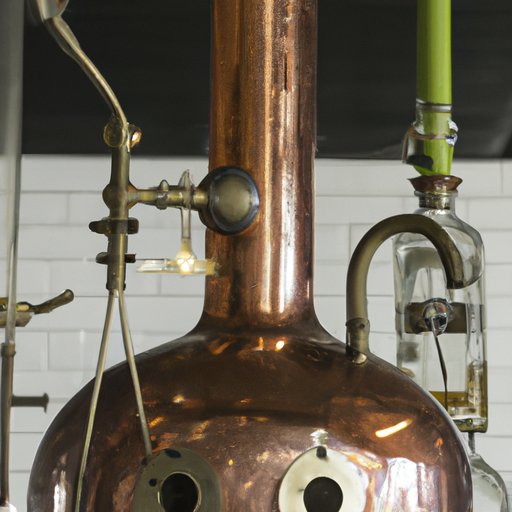Introduction
A still is a device used for distilling liquid mixtures by heating them to separate components. It is most commonly used to make alcoholic beverages such as whiskey, vodka, and gin, but it can also be used to make essential oils, perfumes, and other products. In this article, we will explore how a still works and provide a comprehensive guide to distilling.
Exploring the Science Behind Stills: How Does a Still Work?
Before delving into the specifics of how a still works, let’s first take a look at the different parts of a still and the process of distillation. A still consists of a container (which holds the liquid mixture), a heat source (such as a stove or burner), and a condenser (which cools the vaporized liquid and collects it as a liquid again). The process of distillation involves heating the liquid mixture until its individual components turn into vapor, then cooling the vapor back into a liquid form. This allows for the separation of the components of the mixture based on their boiling points.
A Step-by-Step Guide to Understanding the Process of Distilling with a Still
Now that we have a basic understanding of how a still works, let’s take a look at the step-by-step process of distillation with a still. Gathering the required materials is the first step: you will need a still, a heat source, some type of container to hold the liquid mixture, and a condenser. Once you have all of these items, you can start preparing the still for use.
To prepare the still, you should first clean and sanitize it, then fill it with the liquid mixture you are going to distill. Next, attach the condenser to the still and connect it to your heat source. Once everything is connected, you can begin the distillation process.
The process of distillation involves heating the liquid mixture until it vaporizes. As the vapor rises, it passes through the condenser and cools down, turning back into a liquid form. This liquid is then collected in a separate container and is now referred to as the “distillate.” During the distillation process, you should constantly monitor the temperature and adjust the heat source as needed.
Once the distillation process is complete, you can enjoy the results! Depending on what you are distilling, the distillate may be ready to drink or may need to be aged before it is ready to consume. If you are making essential oils or perfumes, the distillate may need to be further processed before it is ready for use.
How to Use a Still: A Comprehensive Guide to Distillation
Using a still can be a fun and rewarding experience, but there are a few things you should keep in mind before you get started. Here are some tips for getting started:
- Make sure you understand the safety considerations involved in using a still, such as proper ventilation and fire safety.
- Read up on the distillation process and familiarize yourself with the different parts of a still.
- Gather the necessary materials, such as a still, heat source, container, and condenser.
- Be sure to thoroughly clean and sanitize the still before use.
- Monitor the distillation process closely and adjust the heat source as needed.
When using a still, you should also be aware of any potential hazards that could arise. For example, if the still is not properly ventilated, it can cause toxic vapors to build up in the air. Additionally, if the still is not properly sealed, it can lead to explosions or fires. Always be sure to follow safety guidelines when using a still.

A Look at Different Types of Stills and Their Uses
There are several different types of stills available for use, each of which has its own unique features and benefits. Let’s take a look at some of the most common types of stills:
Copper Stills
Copper stills are the most common type of still and are typically used for making alcoholic beverages. Copper is a great material for stills because it is a good conductor of heat and does not corrode easily. Copper stills can also be easily customized to fit different needs.
Pot Stills
Pot stills are similar to copper stills, but they are usually smaller and simpler in design. They are often used for making small batches of whiskey or other spirits. Pot stills are also relatively easy to use and maintain.
Reflux Stills
Reflux stills are more complex than copper and pot stills and are typically used for making high-proof spirits. These stills use a column of plates to condense the vaporized liquid, allowing for a higher purity of the final product.
Column Stills
Column stills are the most efficient type of still and are typically used for large-scale production. These stills use a long column filled with packing material to separate the components of the liquid mixture. Column stills can produce a higher quality of distillate than other types of stills.
The Basics of Making Alcohol with a Still: A Beginner’s Guide
Making alcohol with a still can be a fun and rewarding experience. To get started, you will need to gather the necessary ingredients, such as grains, fruits, vegetables, or other fermentables. You will also need to prepare the still for use, such as cleaning and sanitizing it, and connecting it to a heat source.
Once the still is prepared, you can add the ingredient and start the process of distillation. During this process, you should constantly monitor the temperature and adjust the heat source as needed. Once the distillation process is complete, you can enjoy the results!
Conclusion
In conclusion, a still is a device used to distill liquid mixtures into their individual components. We explored how a still works and provided a comprehensive guide to distilling, including a step-by-step guide to understanding the process of distilling with a still, tips for getting started, and a look at different types of stills and their uses. Finally, we discussed the basics of making alcohol with a still. With this knowledge, you can now confidently use a still to make your own alcoholic beverages or other products.
(Note: Is this article not meeting your expectations? Do you have knowledge or insights to share? Unlock new opportunities and expand your reach by joining our authors team. Click Registration to join us and share your expertise with our readers.)
